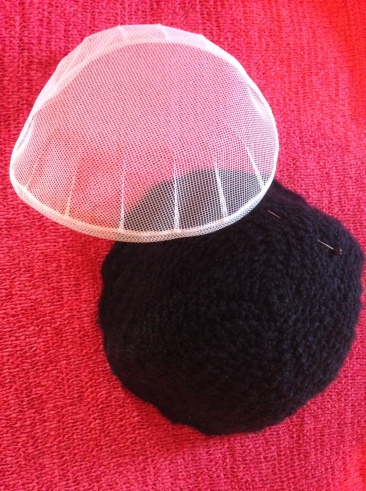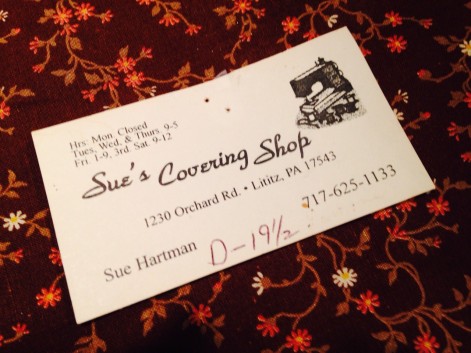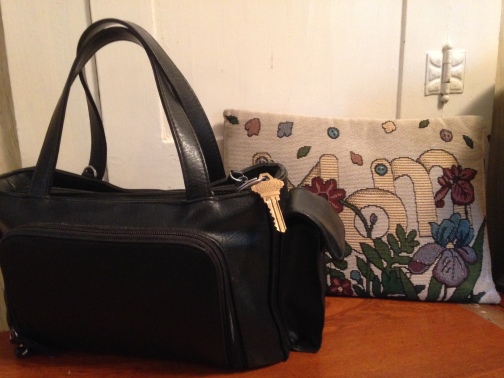My Mother Ruth Landis Metzler was a simple girl who grew up on a farm near Lititz, Pennsylvania and attended Erb’s Mennonite Church. As a young woman, she wore plain clothing and never cut her hair. Her adornment was of the biblical kind as the Apostle Paul admonishes:
I also want the women to dress modestly, with decency and propriety, adorning themselves, not with elaborate hairstyles or gold or pearls or expensive clothes . . .
I Timothy 2:9 NIV
As we sorted through her personal effects recently, we found two prayer coverings and three bonnets, all miniature versions of those large sizes (jumbo, actually) she wore during her girlhood and all through the years we children lived at home.
 On the clipboard in her kitchen, we found the business card to the Sue’s Covering Shop in Lititz where she bought her most recent headgear, the black bonnet now rivaling the size of a Jewish yarmulke and fastened with a shiny black-tipped hat pin.
On the clipboard in her kitchen, we found the business card to the Sue’s Covering Shop in Lititz where she bought her most recent headgear, the black bonnet now rivaling the size of a Jewish yarmulke and fastened with a shiny black-tipped hat pin.
Size mattered among the various congregations in the Lancaster Mennonite Conference in all the years my mother wore prayer coverings. Handwritten on Sue’s Covering Shop business card was Mother’s latest size: D – 19 1/2. When I called Sue’s, the clerk said that D indicates the pattern number, the higher the number (okay, it’s a letter) the larger the size. And 19 1/2 describes the inches around the circumference of her covering.
Hankies, now replaced by Kleenex, were once a part of every woman’s wardrobe. As a young child, my offering (a penny as a toddler, and later a nickel as I grew older) was tied into one corner of my white handkerchief, so I could untie the knot and put the coin into the tin box my teacher passed around during the Sunday School class. Surprisingly, Mother’s hankies were fancy, some even gaudily so, and one even boasts green tatting.
Mom’s purses have usually been black and serviceable though we found set aside a hand-tooled leather purse and remember a lacquered basket-weave popular in the 1950s and 60s. In the October 2014 issue of Guideposts, Malinda Bertels takes stock of her Grandma’s purse and finds in it tissues for applying rouge, a vial of holy water and a faded inscription on a small wooden cross which provides insight and courage to move forward. Mom’s purse contained none of those things, only the bare essentials.
The very last purse she ever carried had a zippered compartment on the outside and all the pockets she liked on the inside for her cards and such. Most important was the pouch on one side, probably designed for a cellphone, but which held her house and car keys. The house key remains, but the car keys have been passed on to a friend from church.
Mother never wore any jewelry except a wrist-watch, but friends bought cute little pins for her anyway. They were never all in one spot, but when we gathered them together, they numbered nine. The only one I ever remember her wearing was the round silver-faceted one, probably to her grandson Austin’s wedding.
Plain and fancy, her wardrobe included the gamut. A plain woman with fancy edges, that was Mom!
A souvenir of their honeymoon, this pillow was found among Mother’s treasures, obviously a gift from Dad, revealing his softer side.
Was/Is your mom plain or fancy? Are you similar or different in fashion sense?





Marian — The collection of hankies is impressive! And while my mom never carried any, my grandma most certainly did (and they always smelled like the roll of Certs mints she was fond of). Looking at the photo of your mom’s purse brought to mind my own mom’s — a veritable treasure trove. Somewhat like Mary Poppins bag, it contained anything and everything you could possibly imagine.
When it came to fashion, my mom was fancy. Me? I pale in comparison.
LikeLike
Fragrances give ready access to memory. Certs mints . . . how interesting. Grandma Longenecker always had a skinny packet of Sen-Sens in her purse, which she would dole out in tiny black squares during the sermon.
Plain or fancy, you count in my books!
LikeLike
Marian — Oh my gosh, I’m cracking up because my other grandma (on my dad’s side) was a Sen-Sen woman, too! I couldn’t stand the taste, but she adored those itty-bitty black squares!
LikeLike
😉
LikeLike
Marian … The crocheted edging on that one handkerchief reminds me so much of gifts that my family exchanged. My Mom also collected pins. I recall getting her some cute ones from the post office – which used to sell such things.
While she and I both have fancy things, we often clung to the plain and simple. 😉 Thank you for sharing.
LikeLike
Pins from the post office – what a concept! I visualize a small-town post office here. Mother never bought pins for herself. They were gifts from others who thought maybe she’d like a little bit of fancy in her life.
It’s always so interesting to hear about other readers’ appreciation of both the plain and the fancy. Thanks for your contribution, Judy.
LikeLike
I love exploring your mom’s simple adornments with you Marian. I was amused at your mom’s place for her cell phone. I have also inherited stashes of simple adornments from my ancestors. Mine also include scarves, silky shiny ones as well as soft warm scarves that are worn on one’s head and tied under the chin.
Myself, I definitely go for plain. When a robber looked through my dresser drawers last July there was nothing really to take, except a 30-year old gold watch that didn’t work anymore.
LikeLike
I like your description of your mother’s scarves. Mother would always call hers bandannas.
Likewise, a robber would be mad or sad or both rummaging through my jewelry box. Thanks for the anecdotes – always good to hear from you, Dolores.
LikeLike
Carrying your offering for church or Sunday school in a knotted corner of a hanky. Wow. I hadn’t remembered that tradition in ages, but we did it too. Great specific memories triggered by this post. My grandmother made all of our coverings, she was quite a seamstress and made her living doing alterations (after her husband died, at the age of 51 or so.) Mom started out plain (hair up, covering to church) but now has short hair, no covering for church or anytime, but still deeply Mennonite, deeply religious. Having her hair cut off was a big deal, happened when I had after I left home.) She always wanted a wedding ring and we children got her a mother’s ring but she never felt right wearing it. Thanks for the memories, Marian.
LikeLike
Your story about your mother’s willingness to cut her hair but resisting wearing a ring points to the conflicted feelings resulting from being a Mennonite in this era. I’m glad this post evoked some buried memories, Melodie. That’s the point, isn’t it!
LikeLike
That one got me a little teary-eyed.
That was interesting about the hat sizing–I had no idea. It’s funny about handkerchiefs. I don’t ever remember having them, but my husband still uses them. ( I think they’re disgusting. 🙂 I was just writing about snuff handkerchiefs today. Some of them carried in the 18th century were quite fancy. I loved the green tatting on your mother’s–a different side of her from the plain black and white, for sure.
LikeLike
Your researching everyday life during the Revolutionary War era probably makes you particularly aware of varied cultural traditions, including PA Mennonites who immigrated in the early 1700s.
Mother usually carried white handkerchiefs to church. I don’t remember her pulling a fancy one out of her purse. I appreciate your comment and the strong feelings behind it, Merril.
(By the way, I commented about your WordPress problem on the previous post. I hope your problem is now solved.)
LikeLike
Thanks, Marian!
LikeLike
I loved learning the meaning of the D-19 1/2 on the business card, Marian.
Reading this honest, lovingly written post brought back many memories of sorting through my aunt’s things after she died. Especially the hankies! She kept them perfectly ironed and folded in a small drawer, with empty bottles of lilac water in the corners of the drawer. Holding them up to my face reminded me so much of how it smelled to hug her, to kiss her cheek, and I could hardly part with any of them. But we gave them–along with shoes, nightgowns, dresses, and gloves– to the women’s shelter. It did my heart good to see one older woman open the box of hankies and do what I’d done: hold them to her face, breathe deeply and smile.
LikeLike
Your loving gift of hankies had come full circle with the recipient from the women’s center enjoying the scent and touch of something personal, feminine too. Great anecdote, Marylin .
LikeLike
Thanks for sharing this nostalgic journey. It was interesting to learn some culture about the bonnets. My mother was in a league of her own. Don’t even get me started. Hence, I wrote a book. 🙂
LikeLike
Ann Lamott remarked that if people wanted us to write more warmly about them in our books they should have behaved better. I must read your memoir!
LikeLiked by 1 person
Ha! I love that quote by Anne. I have it posted everywhere. 🙂 It is truth.
LikeLike
Plain she may have been Marian but there was certainly a very stylish side to her! I have a few antique-y handkerchiefs (was difficult to spell that word) and I wouldn’t trade them for the world. Her handbag looks super smart and I love the pillow and the pins .. lovely post thank you!
LikeLike
It’s nice to hear from you again, Susan. Yes, Mother did have a certain stylish side to her. My sisters and I have remarked how she expressed her fancy self in dressing us with frocks with embroidery and smocking and cute little bonnets and hats for spring, especially at Easter time. I notice the contrast between plain and fancy more in retrospect.Thanks for pointing that out.
LikeLike
I’ve written two comments and they’ve both disappeared! I give up. Sorry.
LikeLike
I see this one. Keep trying, Anita.
LikeLike
One more try. I have a box of very fancy handkerchiefs. My mother had two long braids that she wrapped around her head twice! My sister and I both had long braids down our backs. We all got our hair cut in the early 50’s but not all at the same time! You bring back so many memories for me! Thanks for sharing!
LikeLike
And thanks for trying one more tim, Anita.. I think the problem must have been a WordPress glitch, not you.
I can picture braided hair because I wore my hair in braids around my head with a prayer veiling most of my teenage years and into my early 20s. But I have a hard time imagining braids so long they could wrap around your mother’s head—twice. I seem to remember that your mother is Norwegian. Right?
LikeLike
Yes, she was full-blooded Norwegian. Then she married an Irishman so I’m both! I have a picture of her with her hair braided, I’ll put it on my blog one of these times.
LikeLike
Poignant and sweet, Marian. I love the touch of fancy in the handies. One of my grandma’s crocheted edges on the white handkerchiefs to fancy them up. The other grandma embroidered them with flowers. Women have always found ways to decorate the simple things of life and make them fancy.
Thanks so much for taking me on this memory journey with you.
LikeLike
Your comment reminds me that Amish women are notable for making fancy, fancy quilts, some of them commanding thousands of dollars in value and gracing the homes of Manhattanites. Yes, women have always been able to make the functional beautiful too. Thanks for stopping by.
LikeLike
My mother was large, loud and impossible to miss. She wore bright colours, had red hair and was fond of talking to anyone and everyone she met. She laughed a lot and loudly and, even today, almost twenty five years after her death, people I meet in the street still tell me how much they miss her.
LikeLike
It sounds like your mother made a positive splash, cultivating lots and lots of friendships. To be remembered twenty-five years after death says something about the legacy of your mother. Thanks for bringing her memory to life in your comment, Marie.
LikeLike
I still remember that my mother-in-law’s sister gathered their mother’s pins and mounted each in a deep oval frame matted against black velvet. I was honored that she gifted one to us. It still sits on my dresser table. I’ve often thought I should do the same with my mother’s mother’s pins and surprise her. Thank you for reminding me to do that for her this Christmas…or sooner.
She also, had handkerchiefs galore with lovely tattying around the edges.
When I attended our church at the city house I served on the altar guild preparing and setting up the elements for communion. Unfortunately, some of the napkins to protect the elements had become stained and appeared over washed and ironed. My thoughts turned to my mother-in-law’s plain and fancy white kerchiefs. They were still in such good condition and some had never been used. I asked the other ladies if it would be appropriate to use them. They readily accepted the donation. I smile thinking they are in the perfect place at the Methodist church she loved so much.
LikeLike
I love the vivid descriptions of the keepsake from your aunt-in-law. I’d like to see a photo of your creation.
Very touching, the story of your giving new life to those plain and fancy white kerchiefs. It made me smile too. Thank you for two lovely anecdotes, Georgette.
LikeLike
Well, my mother was fancy, then she was plain, and now she is fancy again. She rode the waves of the Mennonite Church in the last 87 years, fancy at the center and plain enough to pass inspection at the edges. I am touched by these material culture artifacts you are now sorting through as you distribute the last vestiges of your mother’s physical self here on earth. I can tell the process has a spiritual effect on you also.
P.S. one whimsical thought — those pins remind me for some reason of Monopoly pieces.
LikeLike
Your mother has a flair for fashion down to her shoes as I can tell from photos of her on your blog and in your book. Yes, the process of sorting has had a spiritual effect on me, including the fact that Mother was more intentional in her choosing/saving than I imagined. Like Joan Didion and so many others, I am taking my grief and turning it into words.
About your whimsical thought on pins as Monopoly pieces: Remember, Mom was a game girl! Your comments are always thought-provoking. Thank you!
I’m still thinking about how I might comment on your post today.
LikeLike
Mama didn’t leave behind voluminous amounts of beautiful “things.” However, one large collection of ladies “hankies” did identify the times and style in which she lived. But what to do with them? The first one was easy. It had crocheted edges embroidered with her name. That one was placed in a shadow box with other memorabilia which illustrated the quality of her life. The sheer volume of the others left me with many options, but no ideas. What to do? Start talking about them, showing them to friends, “what would you do with these?”
The end product was multiple, colorful pillows that I handed down to each of my four nieces, personally chosen by them. The “left overs” we’re used in a wall hanging collage along with other items from mama’s collection of buttons and costume jewelry. A picture puzzle of a beautiful, southern steel magnolia.
LikeLike
The shadow box is a glorious tribute to your mother. Also, I like how you engaged others in finding ways to preserve and display the remaining items. Obviously, she was a steel magnolia, just like you.
LikeLike